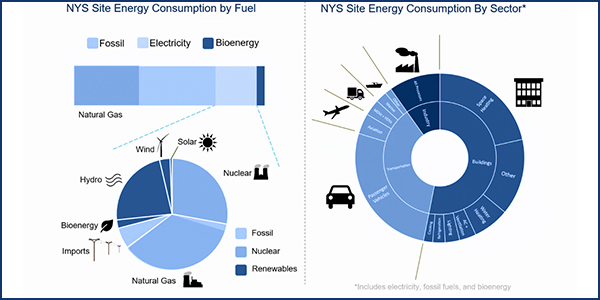The Power Generation Advisory Panel of the New York Climate Action Council (CAC) held its final meeting of the year on Dec. 21, looking back with satisfaction on its year’s work but acknowledging that much needs to be done, and quickly, to meet the state’s ambitious clean energy goals.
“I would remind people, we are out of time,” said John Reese, senior vice president of Eastern Power Generating Co.
The Climate Leadership and Community Protection Act (CLCPA) requires the state to consume 70% renewable electricity by 2030, switch to 100% zero-emission electricity by 2040 and reduce greenhouse gas emissions to 85% below 1990 levels by mid-century.

New York state energy consumption by fuel and by sector | Energy and Environmental Economics, E3
Barriers to development include money, efficiency in procurement and processing, and getting projects through the interconnection queue, where often the local utility is an obstacle, Reese said.
Barriers to Buildout

A poor audio connection prevented panel chair John Rhodes, chairman of the state Public Service Commission, from reporting on the various subgroups, which NYISO Executive Vice President Emilie Nelson covered in his place.
The Barriers Subgroup, focused on clean energy siting and energy delivery and hosting capacity, met several times in the fall and established a weekly cadence for meetings going forward.
“Much of our discussion has been on the need for transmission and distribution buildout, as well as those other technology solutions,” Nelson said, referring to storage and improved data collection. “We discussed physical limitations, particularly in the metropolitan areas of New York City [with siting of storage].”

Lisa Dix, Sierra Club | NYDPS
The subgroup also discussed the importance of allowing renewable resources to access the transmission system and the need to address border flow issues that could impede energy delivery, she said.
Sierra Club representative Lisa Dix discussed with the subgroup the need to scale storage to hit the 3-GW target by 2030 and how the state can assist in making that happen.
Bill Acker, executive director of the New York Battery and Energy Storage Consortium (NY BEST), said, “We have the barriers around getting to the near-term solution of 70% renewables, and then the barriers around getting to a carbon-free solution, which is a more daunting task by far.”
Solutions for the Future
The Solutions for the Future Subgroup is addressing reliability of the future grid, including storage and flexible, dispatchable resources.

Bill Acker, NY-BEST | NYDPS
A topic called the last clean megawatts (also called the final X percent), is about encouraging the necessary market investments for future innovation in energy delivery, Nelson said.
“There was acknowledgement of the different elements needed to encourage innovation, and discussion about the longer-term developments needed in the markets to encourage the transition that is happening across the system,” Nelson said.
The subgroup discussed whether carbon pricing should be applied through wholesale power markets, or if it’s better to have a broader mechanism that applies economy-wide, she said.
The Resource Mix Subgroup had “a really long list” of topics, including the electrification of buildings and transportation; the natural gas system; downstate peakers; instate renewables; regional connections; local distributed energy resources; and energy storage, Nelson said. (See NY Panel Examines Vehicle Electrification, Cleaner Fuels.)
“There was quite a bit of review of the impact that peakers have on local communities, but also on how we will define peakers in the future,” she said. “One would anticipate that as renewable buildout really increases, the remaining fossil base really will only perform on a peaking basis.”
Equity Subgroup
The CLCPA requires that 40% of the benefits of state investments in clean energy reaches disadvantaged communities, such as those located near the dirtiest oil and gas-fired peaker plants.

Betta Broad, NYCP | NYDPS
Betta Broad, outreach director at New Yorkers for Clean Power, summarized the meetings of the Equity Subgroup, which focused on community impacts, affordability and access for all, and workforce development.
“There’s a lot of concern about the disproportionate impacts on communities living near high-emission plants and peaker plants downstate, and on how we are going to close those plants as quickly as possible,” Broad said. “We’ve been talking about the need for real sunset dates and having a plan for scaling up and retiring those most-polluting plants.”

Annel Hernandez, NYC Environmental Justice Alliance | NYDPS
In a discussion on workforce development, the subgroup wanted to see long-term careers for residents, “not just a temp situation,” said Jennifer Schneider, state coordinator for the International Brotherhood of Electrical Workers.
Annel Hernandez, associate director of the New York City Environmental Justice Alliance, said she wanted to stress the importance of making sure large-scale renewable energy projects maximize local workforce benefits.
“It’s important to build these industries in New York City and New York state and make sure it’s inclusive of environmental justice communities that have been historically left out,” Hernandez said.



